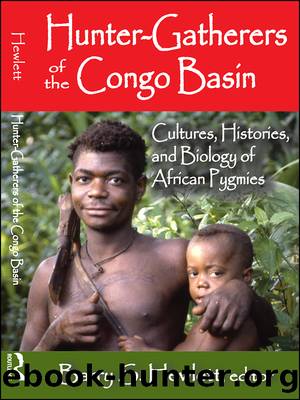Hunter-Gatherers of the Congo Basin by Barry S. Hewlett

Author:Barry S. Hewlett [Hewlett, Barry S.]
Language: eng
Format: epub
ISBN: 9781412853613
Barnesnoble:
Publisher: Transaction Publishers
Published: 2014-05-30T00:00:00+00:00
Possibility of Foraging Lifestyle in the African Tropical Rainforest
Food brought back to the camp during the three survey periods consisted of various food types: yams and yam-like tubers (six species), mammals (twelve species), freshwater fish (nineteen vernacular names), termites (one vernacular name), honey (one species and two vernacular names), nuts (four species), edible fungi (eighteen vernacular names), and so on. Among these, yam and yam-like tubers ranked highest in weight in all three seasons. Mammals ranked second in both the minor dry and the major rainy seasons, followed by fish in the former and nuts in the latter. Honey ranked second, and fish ranked third in the minor dry season, when very few mammals were caught (table 6.2).
We derived the total food intake of cooperators and their children from the weight of all food acquired, less any leftoversâthe bulk of which was preserved dry meat taken back to their settlementâand the amount of food discarded during each survey period. We estimated the total energy intake at 2,528â2,864 kcal per consumption day in the minor dry season, at 2,479â 2,777 kcal in the major rainy season, and at 2,000â2,184 kcal in the minor rainy season (table 6.3). The total energy intake per consumption day in the minor rainy season was much smaller than those in the minor dry and major rainy seasons because very little game meat and a fairly small amount of nuts were brought into the camp. Yam and yam-like tubers supplied dietary energy of over 1,500 kcal and more than 60 percent of the total energy intake in all three seasons. There was no significant difference in food energy between the amount of edible food brought into camp during the first half of each survey compared to that brought in during the second; however, we did observe a tendency for food energy to decrease during the latter half of the minor rainy season survey, contrastingly to the surveys in the minor dry and major rainy seasons (table 6.4).
Download
This site does not store any files on its server. We only index and link to content provided by other sites. Please contact the content providers to delete copyright contents if any and email us, we'll remove relevant links or contents immediately.
De Catalaanse brief by Robert Goddard(317)
A Piece of Cake by Sarah Swatridge(251)
Churchill's Spearhead by John Greenacre(227)
Nonlinear Dynamics and Chaos with Student Solutions Manual by Steven H. Strogatz(221)
The Ruin of J. Robert Oppenheimer by Priscilla J. McMillan(194)
Popular Culture and Political Identity in the Arab Gulf States by Alanoud Alsharekh Robert Springborg(174)
Flowering of the Cumberland by Harriette Simpson Arnow(174)
thing bounces back europe by Unknown(165)
Allied Bombing Raids by Philip Kaplan(164)
A Japanese View of Nature by Kinji Imanishi Pamela J. Asquith(157)
Guild and State by Antony Black(153)
Comet Madness by Richard J. Goodrich(153)
RAF at the Crossroads by Greg Baughen(140)
History Without A Subject by David Ashley(136)
A History of Greek and Roman Philosophy by John Hackney(135)
The Seventies Now: Culture As Surveillance by Stephen Paul Miller(135)
A History of Science in Society by Ede Andrew;Cormack Lesley B.;(131)
Air Battle for Burma by Evans Bryn;(128)
Shocking Bodies by Iwan Rhys Morus(126)
